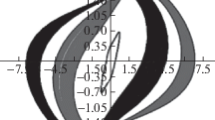Abstract
Systems with multiscroll attractors have been studied extensively in recent decades. Some efforts have focused on understanding the mechanisms that generate complex dynamics in relatively simple systems. The chaotic properties of these systems have been found useful in cryptographic techniques. Recently, hidden chaotic attractors have raised interest in cryptographic algorithms due to the additional complexity they provide. Although several hidden chaotic attractors have been reported, the variety of mechanisms involved in the appearance of hidden attractors in multistable systems is not fully understood. Here we report an approach to generate multistable systems with nested hidden attractors. The idea behind the construction is to use a nonlinear function to produce coexisting self-excited attractors at specific locations. So, a hidden attractor emerges for each pair of self-excited attractors, each pair of these hidden attractors leads to the appearance of a larger hidden attractor. In this way, hidden nested attractors appear depending on the number of self-excited attractors. Therefore, the systems produced with the approach could possibly be used in a cryptographic algorithm. The new dynamical system to generate nested attractors starts by selecting three parameters which are related to the oscillatory behavior and appear in the linear part (matrix A) of the system equations. Then, using the proposed simplest system description, two parameters, which are related to the location of the equilibria, are adjusted in order to generate a bistable behavior with two self-excited attractors. Each of these self-excited attractors is generated by a pair of equilibrium points. Thus the two self-excited attractors emerge when the relationship between the separation of the two pairs of equilibria and the separation by pairs of equilibria is large enough, which is controlled by two parameters. The bistable behavior is found by choosing the appropriate parameters of the matrix A. Once the bistable behavior has been verified, the found parameters are used in the appropriate proposed description of the system for the desired number of attractors. A particular case with fifteen attractors is introduced.



Similar content being viewed by others
References
G. Leonov, N. Kuznetsov, V. Vagaitsev, Phys. Lett. A 375, 2230–2233 (2011)
X. Jin, X. Duan, H. Jin, Y. Ma, Entropy 22, 610 (2020)
S. Jafari, J.C. Sprott, S. Mohammad Reza Hashemi Golpayegani, Phys. Lett. A 377, 699–702 (2013)
D. Cafagna, G. Grassi, Commun. Nonlinear Sci. Numer. Simul. 19, 2919–2927 (2014)
Z. Wang, S. Cang, E. Oketch Ochola, Y. Sun, Nonlinear Dyn. 69, 531–537 (2012)
C. Li, J.C. Sprott, W. Thio, H. Zhu, IEEE Trans. Circ. Syst.-Part II Express Briefs 61, 977–981 (2014)
J.M. Munoz-Pacheco, E. Zambrano-Serrano, C. Volos, S. Jafari, J. Kengne, K. Rajagopal, Entropy 20, 564 (2018)
H. Xiaoyu, C. Liu, L. Liu, J. Ni, S. Li, Nonlinear Dyn. 86, 1725–1734 (2016)
H. Xiaoyu, C. Liu, L. Liu, Y. Yao, G. Zheng, Chin. Phys. B 26, 110502 (2017)
F. Rahma Tahir, S. Jafari, V.-T. Pham, C. Volos, X. Wang, Int. J. Bifurc. Chaos 25, 1550056 (2015)
M.A. Kiseleva, N.V. Kuznetsov, G.A. Leonov, IFAC-PapersOnLine. In: 6th IFAC Workshop on Periodic Control Systems PSYCO 2016, 49, 51 – 55 (2016)
M.-F. Danca, N. Kuznetsov, G. Chen, Nonlinear Dyn. 88, 791–805 (2017)
R.J. Escalante-González, E. Campos-Cantón, Int. J. Mod. Phys. C 28, 1750008 (2017)
R.J. Escalante-González, E. Campos-Cantón, M. Nicol, Chaos Interdiscipl. J. Nonlinear Sci. 27, 053109 (2017)
R.J. Escalante-González, E. Campos-Cantón, IEEE Trans. Circ. Syst. II Express Briefs 66, 1456–1460 (2019)
L.J. Ontañón-García, E. Campos-Cantón, Nonlinear Anal. Hybrid Syst. 26, 38–47 (2017)
R.J. Escalante-González, E. Campos, Complexity 2020, 1–12 (2020)
A. Wolf, J.B. Swift, H.L. Swinney, J.A. Vastano, Phys. D 16, 285–317 (1985)
F. William, Introduction to Real Analysis (Faculty Authored and Edited Books & CDs, San Antonio, 2013)
Acknowledgements
R. J. Escalante-González is thankful to CONACYT for the scholarships granted. Eric Campos acknowledges CONACYT for the financial support through Project No. A1-S-30433.
Author information
Authors and Affiliations
Corresponding author
Rights and permissions
About this article
Cite this article
Escalante-González, R.J., Campos, E. Multistable systems with nested hidden and self-excited double scroll attractors. Eur. Phys. J. Spec. Top. 231, 351–357 (2022). https://doi.org/10.1140/epjs/s11734-021-00350-3
Received:
Accepted:
Published:
Issue Date:
DOI: https://doi.org/10.1140/epjs/s11734-021-00350-3




